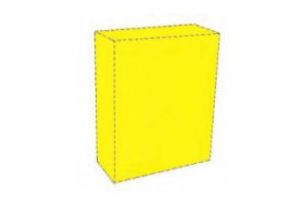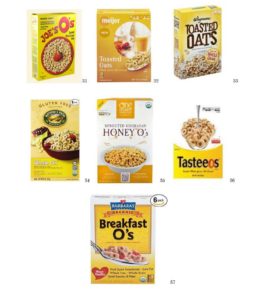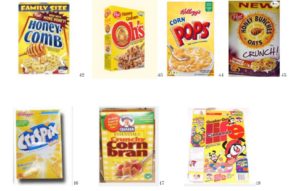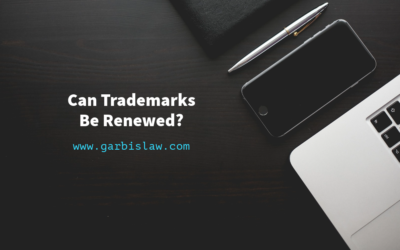Did you know that the colors applied to a product or its packaging can function as a trademark and be entitled to registration under the Trademark Act? Companies like UPS (brown), T-Mobile (magenta), Target (red), John Deere (green and yellow) all have registered trademarks on the colors of their branding.
But what about your breakfast?
If I were to ask what cereal comes in the box below, what would you tell me? Do you think of a single brand, or are there multiple possibilities?

General Mills feels like you would always say “Cheerios” and as a result had filed an application to register the mark shown above for a “toroidal-shaped, oat-based breakfast cereal.” Registration of this mark was requested under Section 2(f) which claims it has acquired distinctiveness. In other words, General Mills claims that the extensive use and promotion of the mark has led to consumers directly associating the mark with the applicant as the source of those goods.
Although General Mills submitted a plethora of evidence to support its claim of acquired distinctiveness, the Trademark Examining Attorney refused registration of the application because a single color mark is not “inherently distinctive, the Applicant failed to demonstrate acquired distinctiveness, and the applied for mark fails to function as a trademark. General Mills appealed to the Trademark Trial and Appeal Board (“TTAB”), who decided this matter on August 22, 2017.
WHAT IS ACQUIRED DISTINCTIVENESS?
In order to establish acquired distinctiveness, also known as secondary meaning, an applicant must show that in the minds of the public, the primary significance of a product feature or term is to identify the source of the product rather than the product itself. Color marks, however, carry a huge burden in proving distinctiveness and that they operate as trademarks.
General Mills Arguments:
General Mills submitted evidence in order to convince the TTAB that the purchasing public recognizes General Mills as the source of the cereal when it comes to yellow boxes of toroidal (ring or doughnut-shaped) oat-based breakfast. Some of the evidence submitted included:
- Oat-based breakfast cereal sold under the brand CHEERIOS since 1945;
- Over $1 billion spent in marketing Yellow Box Cheerios during the previous decade;
- Sales over $4 billion in that decade;
- A 2014 Super Bowl commercial for CHEERIOS which aired 200 times;
- Articles addressing the popularity of CHEERIOS;
- A survey in which subjects were shown an image of an unmarked, yellow, rectangular box and were asked “If you think you know, what brand of cereal comes in this box?”
TTAB Analysis:
The TTAB makes sure to stay on track here and recognizes the true issue in this case. The question is not whether customers recognize the term CHEERIOS as a source identifier, but whether customers recognize the “color yellow on a package of toroidal-shaped, oat-based breakfast cereal” as an indicator that the cereal in the box comes from the maker of CHEERIOS.
When reviewing the initial application, the Examining Attorney rejected it, arguing that the proposed mark does not function as a trademark because purchasers will perceive the color yellow merely as a decorative feature. She points to the fact that purchasers are used to seeing cereal boxes in a variety of colors, including yellow; even on ring shaped oat-based cereals. Therefore, the color’s primary purpose is to serve as decorative as opposed to indicating the source of the goods.
When analyzing color marks, courts look at the nature of the goods, how the color is actually used, the number of different colors and color combinations used, the number of competitors in a given field, and customary marketing practices. The TTAB looks at all of these factors and ends up agreeing with the Examining Attorney, that the yellow box is not a source identifier.
One of the major problems with General Mills’ claim is that there are a number of other competitors using yellow on their boxes. This non-exclusive use poses a problem in developing trademark rights.
“Distinctiveness is acquired by ‘substantially exclusive and continuous use’ of the mark in commerce. A color which is employed by others in the industry acts not as an indicator of source but as mere ornamentation.” In re Owens-Corning Fiberglass Corp., 227 USPQ 417, 424 (Fed. Cir. 1985)
The Examining Attorney showed 23 examples of cereal products that had packaging similar to that of General Mills. Of those 23, the TTAB pointed out the following ring-shaped, oat-based cereals offered under the brands Trader Joe’s, Meijer, Wegmans, Nature’s Path, One Degree, Ralston, and Barbara’s:

The TTAB reasons that this evidence proves General Mills is not exclusively offering its toroidal-shaped, oat-based cereal in a yellow package. The fact that there are a number of competitors offering similar products in similar packaging, establishing the color yellow as its trademark is difficult. The TTAB also gives more examples of other products from Kellog, Post, and Quaker offering their cereals in yellow boxes:

Even though General Mills limited its application to cover “toroidal-shaped, oat-based breakfast cereals,” the TTAB feels that the presence of all of these products and competitors in yellow packaging would detract from the public exclusively associating a yellow cereal box with Cheerios. Instead of being seen as a source identifier, customers would likely view the yellow color as a general color used on cereal packaging for design purposes.
The TTAB also considered the survey administered by General Mills to 419 subjects. The results of that survey came back with roughly 49% of the subjects associating the yellow box with CHEERIOS. The TTAB, however, concluded that the questions of the survey were not worded properly. Specifically, after being shown the same image I showed you in the beginning of this article, subjects were asked: “If you think you know, what brand of cereal comes in this box?”
The problem with that question is that it makes the subjects believe there is only one brand that should be named. The TTAB concluded that “Question 1 likely elicited from the subjects the first brand that came to mind, but unless the subjects spontaneously elaborated, the survey would not show whether subjects believed the color yellow was associated only with the maker of the Cheerios brand.”
Taking everything into account, including industry standard practices of using bright colors, bold graphics, and prominent word marks on cereal boxes, as well as the public’s exposure to a number of similar packaging from other competitors, the TTAB ruled that General Mills has not shown the yellow box has acquired distinctiveness and does not function as a trademark.
What do you think? Should the color yellow be allowed to pass as a cereal trademark? Do you only think of Cheerios when you see a yellow cereal box?





